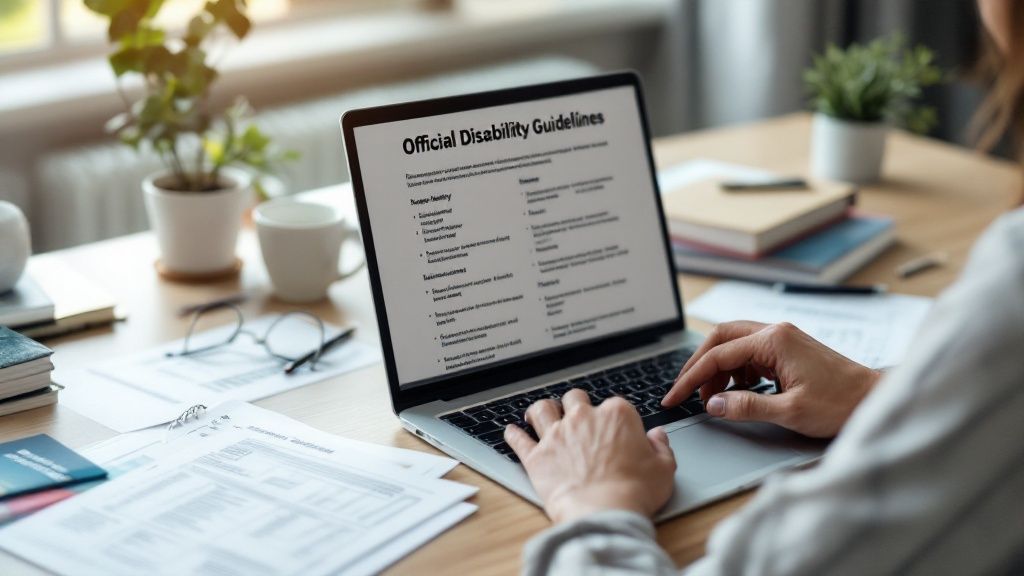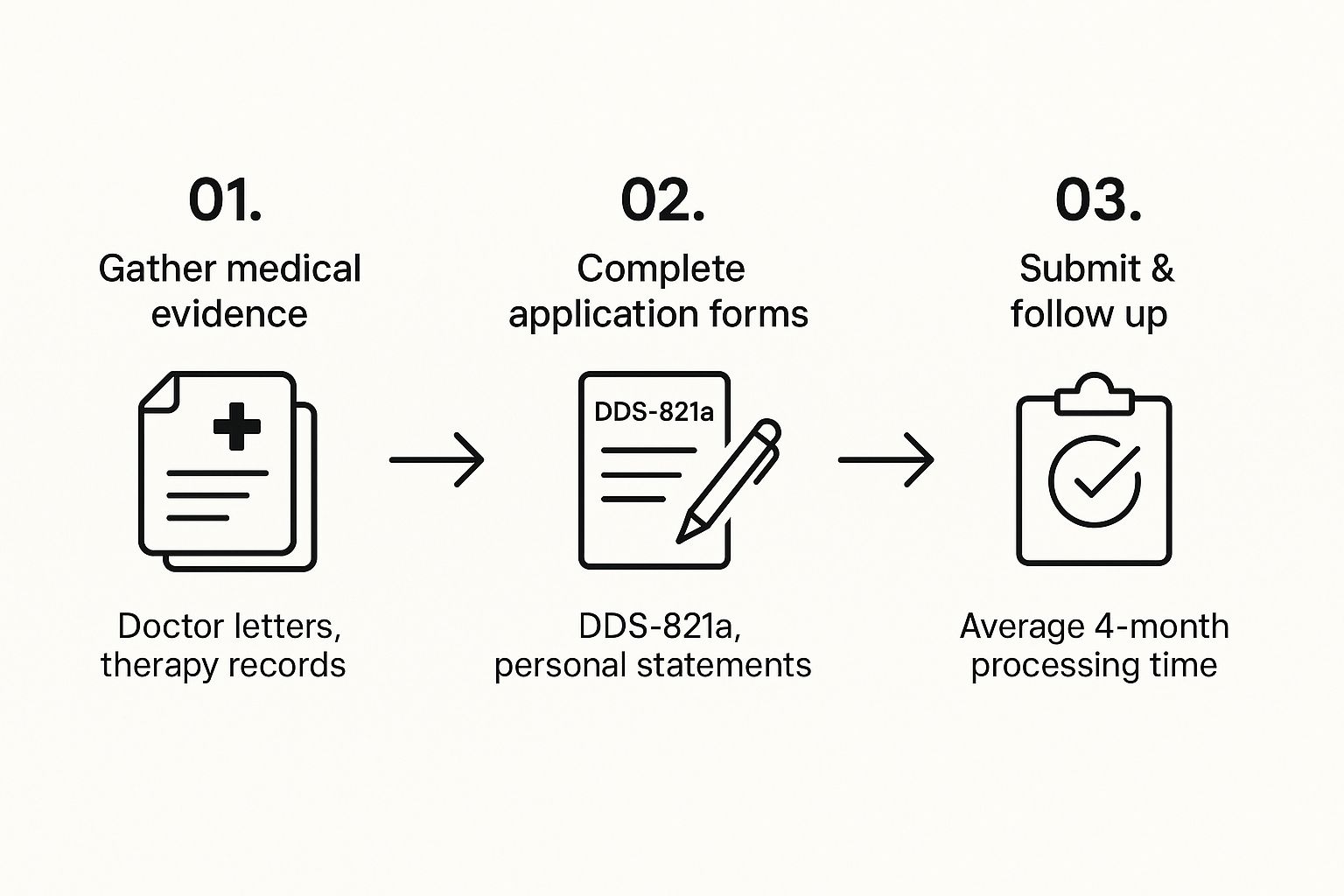How to Get Disability for Anxiety Disorder: Your Essential Guide
"I was satisfied once John Bell took over my case."
"Communication was always timely."
How to Get Disability for Anxiety Disorder: Your Essential Guide
Getting Social Security disability benefits for an anxiety disorder isn't just about having a diagnosis. The Social Security Administration (SSA) needs to see concrete proof that your condition is so severe it completely prevents you from working.
Your entire case hinges on proving that your limitations—not just the label of "anxiety"—stop you from performing what they call substantial gainful activity (SGA). This means gathering a mountain of medical evidence to clearly show how your symptoms impact your day-to-day ability to function.
How the SSA Actually Evaluates Anxiety Claims

Here’s the single most important thing to understand: the SSA doesn't approve benefits based on a diagnosis. Their one and only focus is on how your anxiety directly limits your ability to show up, focus, and perform in a work setting.
This is a crucial point where many applications fall short. You can have a well-documented history of Generalized Anxiety Disorder, Panic Disorder, or PTSD, but if the SSA reviewer isn't convinced you're unable to perform basic work tasks reliably, your claim will be denied.
Your application needs to paint a vivid, consistent picture, backed by your doctor's records, of why sustained work is impossible for you.
SSDI vs. SSI: Which Path Is Right for You?
The SSA runs two different disability programs, and figuring out which one fits your situation is the first real step. They both use the same medical rules to decide if you're disabled, but the financial requirements are worlds apart.
- Social Security Disability Insurance (SSDI): Think of this as an insurance program you've paid into. It’s for people who have a solid work history and have paid Social Security taxes long enough to earn "work credits." The benefit amount you receive is calculated based on your average lifetime earnings.
- Supplemental Security Income (SSI): This is a needs-based program. It's designed to help disabled adults and children who have very limited income and few assets, regardless of how much they've worked in the past. If you haven't earned enough work credits for SSDI, this might be your path.
It’s actually possible to apply for both at the same time, especially if you have some work history but still fall under the strict income and asset caps for SSI.
SSDI vs SSI for Anxiety Quick Comparison
When you're dealing with an anxiety disorder, the financial side of things can be just as overwhelming as the medical side. This table breaks down the core differences between the two main disability programs to help you see where you might fit.
| Eligibility Basis | Based on your work history and FICA tax contributions (work credits). | Based on financial need (very limited income and resources). |
| Income/Resource Limits | No limits on unearned income or assets. | Strict limits on income ($943/month for an individual in 2024) and resources ($2,000). |
| Medicare/Medicaid | Automatically eligible for Medicare after a 24-month waiting period. | Often automatically eligible for Medicaid immediately upon approval. |
| Benefit Amount | Varies based on your lifetime average earnings. | A fixed federal monthly amount, which may be reduced by other income. |
Understanding these distinctions is key because it shapes which program you should focus your application on. For many, the choice is clear based on their work and financial history.
The Bottom Line: The SSA's decision isn't about if you have anxiety. It's about whether that anxiety keeps you from earning a living. Your entire application is built to answer that one question.
The SSA’s Official Rulebook: The Blue Book
To keep their decisions consistent, the SSA uses a medical guide called the "Blue Book." Section 12.06 is the part that specifically details the criteria for Anxiety and Obsessive-Compulsive Disorders.
Meeting the criteria in this listing is the most straightforward path to approval, but it's not the only one. The requirements are incredibly strict.
Many people win their cases by proving that even if they don't perfectly match the Blue Book listing, their Residual Functional Capacity (RFC)—what you can still do despite your limitations—is so restricted that there are no jobs they can perform. This is where the details about your inability to concentrate, interact with others, or manage stress become absolutely vital.
Anxiety disorders are far more common than people realize, affecting 19.1% of U.S. adults each year. Yet, globally, only about one in four people with these conditions get any treatment. This statistic, highlighted on the South Denver Therapy blog, underscores why building a long-term, well-documented medical history is one of the biggest challenges—and most important steps—in filing a successful disability claim.
Building a Medical File the SSA Can't Ignore

Let's be clear: your medical records are the absolute bedrock of your disability application. The Social Security Administration (SSA) doesn't approve claims based on what you say—they approve them based on what your doctors have documented over time.
A thin medical file is one of the quickest ways to get a denial letter. Just having a diagnosis for Generalized Anxiety Disorder or Panic Disorder on paper isn't nearly enough. Your records have to paint a vivid, consistent picture of your symptoms, the treatments you've tried, and most importantly, how it all stops you from being able to work.
Think of your file as the evidence in a court case. Every therapy note, every prescription history, every visit to your primary care doctor—it’s all proof that your condition is severe and long-lasting.
It's More Than Just a Diagnosis
To build a truly compelling case, you need to think beyond just your psychiatrist's notes. While those are obviously critical, records from your primary care physician (PCP) can be incredibly powerful. Anxiety often shows up in physical ways, and getting those symptoms documented is essential.
Your goal is to create a complete picture for the SSA. A strong file will typically include:
- Psychiatric Evaluations: These are the formal diagnostic reports from your psychiatrist or psychologist.
- Therapy Session Notes: Consistent notes from your therapist show a clear pattern of your struggles and a history of you actively trying to get better.
- Prescription Histories: A detailed log of the medications you've tried, including dosages and side effects, proves you are following prescribed treatment.
- Primary Care Records: This is where you document the physical fallout from anxiety—things like chronic fatigue, stress-induced migraines, digestive problems like IBS, or chest pains that mimic a heart attack during a panic episode.
For many people, options like effective online counselling for anxiety provide a consistent way to build this medical history, which is absolutely vital when you're trying to get disability benefits for an anxiety disorder.
The Deciding Factor: A Medical Source Statement
If there's one document that can make or break your claim, it's a detailed statement from your treating doctor. This is often called a Residual Functional Capacity (RFC) form or a Medical Source Statement. This isn't just a generic letter; it's a specialized form that translates your medical diagnosis into the language the SSA actually understands: work-related limitations.
A well-written RFC from your doctor will assess your ability to handle specific job tasks, such as:
- Maintaining concentration and a consistent pace for an 8-hour workday.
- Understanding, remembering, and carrying out instructions (from simple to complex).
- Interacting appropriately with supervisors, coworkers, and the general public.
- Adapting to routine changes in a work setting.
- Coping with normal, day-to-day work stress.
If you don't provide this, the SSA will have their own doctors—who have never met you—review your file and make their own judgment call. A detailed statement from the doctor who knows your history best carries immense weight and can single-handedly turn a denial into an approval.
A thoroughly completed RFC form from your long-term psychologist can be far more persuasive than hundreds of pages of raw medical data. It directly connects your diagnosis to your inability to work.
How to Talk to Your Doctor So They Can Help You
Your doctor can only write down what you tell them. When you go to your appointments, you have to be specific about how your anxiety cripples your ability to function. Vague comments like "I feel anxious" won't cut it.
Give them concrete, real-world examples. Instead of saying you have trouble concentrating, describe what that actually looks like. Try something like, "Yesterday, I tried to follow a simple recipe for dinner and had to re-read the first step five times because my mind was racing. I got so overwhelmed I just gave up and had cereal instead."
This kind of specific detail gives your doctor the tangible information they need to put in their notes—the same notes the SSA will be reading. For a deeper dive, our guide on how to get medical records walks you through the practical steps of gathering all these crucial documents.
Just imagine two different claim files sitting on an SSA examiner's desk:
- Case A (The Thin File): A simple diagnosis of "Generalized Anxiety Disorder." The file shows three doctor visits over the past year with a prescription for Zoloft. The notes are brief and lack any real detail.
- Case B (The Compelling File): A GAD diagnosis backed by monthly therapy notes that detail panic attacks and avoidance behaviors. PCP records show multiple visits for stress-induced migraines. Best of all, a psychiatrist's RFC form explicitly states the person cannot maintain a regular schedule and has "marked" limitations in interacting with others.
Case B tells a story. It proves a severe, persistent condition and directly links it to the inability to perform basic work tasks. That's the key to getting a disability claim for an anxiety disorder approved.
Meeting the Blue Book Criteria for Anxiety Disorders

The Social Security Administration (SSA) doesn't just take your word for it; they have a massive medical guide called the "Blue Book" that lays out exactly what they consider a disabling condition. When you're applying for disability benefits due to an anxiety disorder, your entire case hinges on Listing 12.06 for Anxiety and Obsessive-Compulsive Disorders.
Think of this listing as a very specific, non-negotiable checklist. If your medical records line up perfectly with what's written here, you have the most direct path to getting your claim approved. But be warned: the standards are incredibly high, and the language is dense and legalistic. The first major hurdle is figuring out what it all means in the real world.
To meet the requirements of Listing 12.06, you have to satisfy two distinct parts: first, the diagnostic criteria (Paragraph A), and second, the functional limitation criteria (either Paragraph B or C).
First, Prove Your Diagnosis Under Paragraph A
Before the SSA even considers how your anxiety impacts your life, they need to see cold, hard proof of your diagnosis. Your medical file can't just say you "feel anxious." It must contain documented, persistent evidence of at least one of the following conditions:
- Generalized Anxiety Disorder, characterized by a constant state of excessive worry, physical tension, and being on high alert.
- Panic Disorder, which involves recurring, unexpected panic attacks and a crippling, persistent fear of having another one.
- Obsessive-Compulsive Disorder (OCD), defined by involuntary, time-consuming obsessions (thoughts) or compulsions (actions).
- Social Anxiety Disorder, marked by a profound and irrational fear of social interactions, being judged, or performing in front of others.
The notes from your psychiatrist, psychologist, or therapist are the foundation here. They must clearly detail the symptoms that led to your specific diagnosis.
Then, Show How Your Condition Limits You Under Paragraph B
Establishing your diagnosis is just step one. The real heart of your claim is proving how severely your anxiety restricts your ability to function. The SSA looks at this across four specific mental abilities. To succeed, you must show an extreme limitation in one of these areas or marked limitations in at least two of them.
So, what’s the difference? A "marked" limitation means your ability to function in that area is seriously compromised. An "extreme" limitation means you have essentially no ability to function in that area at all.
Let's break down what these four areas look like in everyday life:
Understand, Remember, or Apply Information
This is all about your basic cognitive abilities—following instructions, solving problems, and using logic. A marked limitation might be someone who can't follow a three-step set of directions without getting lost or someone whose anxiety is so severe they can't fill out a simple job application without becoming completely overwhelmed.
Interact with Others
This covers your ability to get along with supervisors, coworkers, and the general public. For someone with social anxiety, a marked limitation could mean being physically unable to make eye contact, answer direct questions, or participate in a team meeting without triggering a panic attack that forces them to leave the room.
Concentrate, Persist, or Maintain Pace
This is a big one for anxiety claims. It's your ability to stay focused and complete tasks efficiently. A marked limitation here is common: racing thoughts cause you to constantly miss critical details at work, or panic attacks force you to stop what you're doing and restart multiple times throughout the day, making it impossible to keep up.
Adapt or Manage Oneself
This area examines your emotional regulation, impulse control, and ability to handle change. A marked limitation might be a person who has a complete emotional breakdown over a minor change in their daily routine, rendering them unable to function for hours.
The Alternative: Proving Your Case Through Paragraph C
What if you're in treatment and it helps, but you're still walking a tightrope? The SSA has an alternative pathway called Paragraph C, which is designed for people with "serious and persistent" mental health conditions.
To qualify under this paragraph, you need a medical history showing your condition has lasted for at least two years. You also need to demonstrate that you're in ongoing treatment (like therapy or medication) that helps manage your symptoms, but you still have a fragile hold on your stability. You struggle to adapt to any new demands or unexpected changes.
Paragraph C essentially acknowledges that some people, even with consistent care, are just one stressful event away from decompensating. The slightest change could unravel everything, making sustained employment impossible. Proving this requires a long-term medical record that paints a clear picture of this ongoing battle and your marginal adjustment.
Ultimately, trying to navigate these complex rules on your own can feel like an impossible task. Taking the time to understand the full Social Security disability requirements is the first, most critical step in building a case that actually speaks the SSA's language.
Tackling the Disability Application Forms
Once you start your application, whether online or over the phone, get ready for a thick packet of paperwork from the Social Security Administration (SSA). Just seeing all those dense forms can feel like a punch to the gut, stirring up the very anxiety you’re trying to get help for. But try to reframe this: these forms are your first real opportunity to tell your story, in your own words.
This isn't just about filling in blanks; it's about building a powerful case. The most important thing you can do is be brutally honest and incredibly specific. The Disability Determination Services (DDS) examiner reviewing your file has never met you. These documents are the only thing they have to go on to understand what your life is actually like.
The Function Report: Your Story, Your Words
One of the most critical documents you'll fill out is the Adult Function Report (Form SSA-3373-BK). This is where you get to paint a detailed picture of how your anxiety disorder wrecks your day-to-day life. Vague answers are your worst enemy here.
Don't just say, "My anxiety makes it hard to be around people." That tells the examiner almost nothing. Instead, give them a real-world example they can sink their teeth into.
"I tried working at a retail store last fall, but I had to run to the restroom three times a day just to breathe through overwhelming panic attacks caused by talking to customers. My supervisor pulled me aside about being away from the register so often, and I was let go after only two weeks because I couldn't handle the constant social interaction."
See the difference? That kind of specific detail connects your diagnosis directly to your inability to hold a job. It gives the DDS examiner a clear, work-related limitation they can understand and document.
This infographic gives you a bird's-eye view of the entire disability claim journey, from gathering your evidence to submitting the final application.

As you can see, this is a marathon, not a sprint. Be prepared for the initial process to take several months.
Explaining Your Work History and Why It Ended
You’ll also need to complete a Work History Report (Form SSA-3369-BK). This form asks for details on the jobs you've held over the last 15 years. Your goal isn't just to list your old titles and duties; it's to explain why you couldn't keep doing them.
For every job you list, connect the dots for the examiner. Show them how your anxiety symptoms got in the way.
- Trouble Concentrating? "My racing thoughts made it impossible to focus on the data entry I was hired for. I made so many errors that my supervisor had to constantly fix my work."
- Struggles with Social Interaction? "I was so afraid of being judged by my coworkers that I started avoiding team meetings and would eat lunch alone in my car. I became completely isolated."
- Poor Attendance? "I burned through all my sick leave in the first three months because of morning panic attacks that were so bad I couldn't physically leave the house."
This level of detail helps the SSA see a pattern—that your inability to work isn't a new thing, but a persistent, long-term struggle.
What to Expect from a Consultative Examination
Sometimes, the DDS examiner will look at your medical records and feel there isn't enough recent information to make a fair decision. If that happens, they’ll schedule you for a Consultative Examination (CE) with a doctor they choose and pay for. This isn't a trap or a trick; it's just their way of getting the missing pieces of the puzzle.
The CE is usually a one-time appointment, so it’s vital that you’re open and honest with the doctor. They aren't there to treat you. Their only job is to assess your condition and write a report for the SSA.
- Talk about your worst days, not just your good ones. Explain how often you have panic attacks and how intense they get.
- Describe your functional limits. Tell the doctor how anxiety stops you from doing everyday things like grocery shopping, cleaning the house, or even checking the mail.
- Be honest. Don't exaggerate, but don't downplay your symptoms either. The doctor is trained to spot inconsistencies. Just describe your reality as accurately as you can.
After all your forms are in and any exams are completed, your file lands on the desk of a DDS examiner. They, along with a medical consultant, will review every single piece of evidence—your doctor’s notes, your function reports, and the CE results—to see if your anxiety disorder meets the SSA's strict definition of disability.
What to Do When Your Anxiety Claim Is Denied
It’s a gut punch. After months of waiting, you get a denial letter from the Social Security Administration (SSA). When you’re already fighting a daily battle with anxiety, a rejection can feel final and devastating.
Take a deep breath. This is completely normal.
The SSA denies the majority of initial disability claims. This isn't the end of the road; it’s just the start of the next phase. You have the right to challenge their decision, and honestly, the appeals process is where many people finally get the benefits they deserve.
The Four Levels of the Appeals Process
The SSA has a very specific, four-level system for appeals. You have to go through them in order, and the clock is always ticking. You typically only have 60 days from the date you receive your denial letter to file each appeal, so you can't afford to sit on it.
- Reconsideration: Your first move is to ask for a "reconsideration." This sends your file to a different examiner at the same agency (Disability Determination Services) for a fresh look. While you can add new medical records, the success rate here is notoriously low. You're essentially asking the same office to admit it got things wrong the first time.
- Hearing by an Administrative Law Judge (ALJ): This is the game-changer. For most people, the ALJ hearing is their best shot at winning. You'll appear before a judge who has had absolutely no prior involvement in your case. This is your opportunity to tell your story in your own words and have an advocate argue for you.
- Appeals Council Review: If the ALJ denies your claim, the next step is the Appeals Council. They don't look at your evidence again; instead, they review the judge's decision for legal or procedural mistakes. They might approve your claim, deny it, or, in some cases, send it back to another ALJ for a new hearing.
- Federal Court Review: Your last resort is to file a lawsuit in U.S. District Court. This is a serious legal battle that focuses only on whether the SSA followed its own laws and procedures when handling your case. It's a long and complex process.
Why the ALJ Hearing Is Your Best Chance to Win
The ALJ hearing is, without a doubt, the most critical stage. Why? Because for the first time, you stop being just a case number on a stack of papers.
The judge gets to see you. They hear the tremor in your voice. They can ask you direct questions and see firsthand how your anxiety truly impacts your ability to function. This human element can make all the difference.
Be ready for some pointed questions about your daily life. The judge is trying to get a real-world picture of your limitations. They'll ask things like:
- "Tell me what happens when you have a panic attack. How long does it last? What do you do?"
- "You mentioned you can't handle stress. Can you give me an example from a previous job where stress created a problem for you?"
- "How do you manage in public places, like a grocery store or a team meeting at work?"
Your testimony, backed by solid medical records, is your most powerful weapon. We know the economic impact of mental health conditions is staggering, leading to massive productivity losses. The World Health Organization reports that over a billion people live with mental health disorders, and anxiety is a key reason people need long-term disability. Explaining how your condition prevents you from working helps the judge understand the severity.
At the hearing, your goal is to paint a crystal-clear picture that connects your anxiety diagnosis to your inability to hold down any job, not just the one you used to have.
The Role of the Vocational Expert
At most ALJ hearings, there's another key person in the room: the Vocational Expert (VE). This is a neutral specialist hired by the SSA to give expert testimony about jobs—what they require and how many of them exist. The VE’s testimony can literally make or break your case.
Here’s how it works. The judge will pose a series of hypothetical questions to the VE based on your medical records. For instance, the judge might ask, "Imagine a person of the claimant's age and work history who is limited to simple, routine work and can only have occasional contact with coworkers or the public. Are there jobs this person could do?"
If the VE says "yes" and lists a few jobs, the judge will likely deny your claim.
This is where your representative earns their keep. Their job is to cross-examine the VE, adding in your specific, documented limitations—like needing unscheduled breaks for panic attacks or being off-task 20% of the day—until the VE has to admit that, no, there are no jobs for someone with that combination of restrictions.
When the VE says, "no jobs," you win. It's a nuanced process, and our in-depth guide on how to appeal a disability denial offers essential strategies for this crucial stage.
Common Questions About Anxiety and Disability Benefits
Trying to get disability for an anxiety disorder brings up a ton of questions. The whole process can feel like a maze, but getting clear answers helps you know what to expect and how to prepare. Let's break down some of the most common things people ask.
Can I Still Get Disability Benefits If I Work Part-Time?
This is a tricky one, but yes, it’s possible. The key is staying under a specific monthly earnings limit set by the Social Security Administration (SSA). This magic number is called the Substantial Gainful Activity (SGA) level.
For 2024, that SGA limit is $1,550 a month for non-blind individuals. If you earn more than that, the SSA will almost always decide you're capable of working and deny your claim. You absolutely have to report any work you do, but keep in mind that a "failed work attempt"—where you try a job but have to leave because your anxiety is too severe—can actually become powerful evidence for your case.
How Long Does an Anxiety Disability Claim Usually Take?
You'll need a lot of patience here, because the timeline can be all over the map. Just getting an initial decision on your application typically takes anywhere from three to six months.
The tough part is that if your claim gets denied and you have to appeal, the whole ordeal can easily drag on for two years or even longer. The biggest hold-up is usually the backlog at the local disability determination and hearing offices.
The waiting game is often the most stressful part of the entire process. While you’re navigating the disability application, it's crucial to keep managing your daily symptoms. You can find practical tips for calming anxiety quickly that might help you cope during this challenging time.
Should I Hire a Lawyer for My Anxiety Disability Claim?
You don't have to hire a lawyer for your initial application, but I strongly recommend it, especially if you get denied and need to file an appeal. An experienced disability lawyer just gets it—they know exactly what kind of medical evidence the SSA needs to see to approve an anxiety case.
A good attorney will take over all the communication with the SSA, get you ready for your hearing, and know just how to question the vocational experts who might testify. The best part? Most work on a contingency fee, meaning they don't get a dime unless you win your case and get back pay.
Does Having Depression or Another Condition Help My Claim?
Yes, without a doubt. When you have more than one diagnosed condition, which doctors call comorbidities, it can really strengthen your disability claim. The SSA isn't just looking at your anxiety in a vacuum; they have to evaluate the combined impact of all your health problems.
So, if you also have documentation for depression, PTSD, or even physical issues like chronic migraines or IBS, it helps paint a much clearer picture of why you can't work. It shows the SSA that your limitations are coming from multiple angles, which makes for a much more compelling case.
At Bell Law, we understand that fighting for disability benefits can feel like a full-time job. If you've been denied or are overwhelmed by the process, our experienced Oregon attorneys are here to build the strongest possible case for you. Contact us for a free consultation at https://www.belllawoffices.com.







